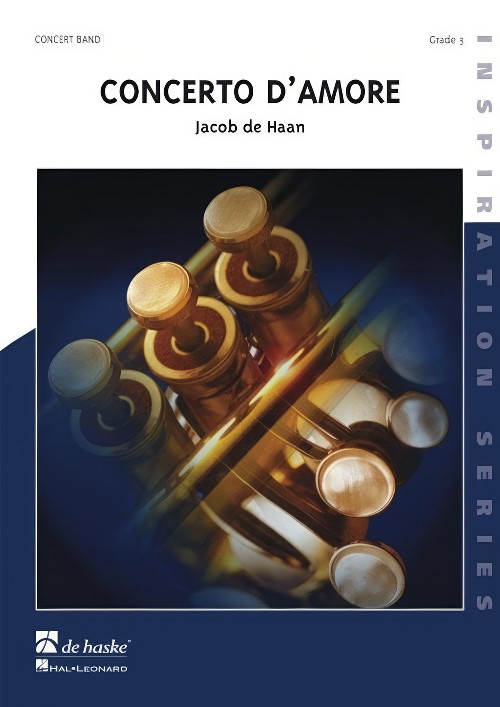Results
-
 £84.99
£84.99Adagio (Clarinet or Oboe Solo with Concert Band - Score and Parts) - Baermann, Heinrich Joseph - Ares, Rob
Solo for Bb Clarinet, Bb Soprano Saxophone or Oboe and Concert Band. Duration: 4.15
Estimated dispatch 7-14 working days
-
 £139.99
£139.99Concerto d'Amore - Jacob de Haan
In Concerto d'Amore, a maestoso opening is followed by a quick and energetic movement that leads to a magnificent adagio. A motif from this adagio can be heard in a swinging movement, after which the piece comes to a close with the return of the adagio. This arrangement for concert band certainly brings this beautiful music to life.
Estimated dispatch 7-14 working days
-
 £139.99
£139.99Concerto d'Amore (Concert Band - Score and Parts) - De Haan, Jacob
In Concerto d'Amore, a maestoso opening is followed by a quick and energetic movement that leads to a magnificent adagio. A motif from this adagio can be heard in a swinging movement, after which the piece comes to a close with the return of the adagio. This arrangement for concert band certainly brings this beautiful music to life.Duration: 7:19
Estimated dispatch 7-14 working days
-
 £37.95
£37.95SYMPHONY No.2 (Novello Symphonic) Score only - Bedford, David
Symphony No.2 contains four movements and a coda, all played without a break, following the traditional symphonic pattern. The Introduction presents the main thematic material of the piece which is characterized by rising and falling 5ths a semitone apart. The Quaver Machine has a repeated, relentless constant quaver pulse from the vibraphone. The harmony circles around only 3 chords and the section builds with more and more instruments being played in harmony and in canon. A shift in tonality gradually leads to Adagio, an almost opulently romantic presentation of the main theme with a rippling accompaniment. After a massive climax, the music leads to Finale with the main theme presented as an Ostinato gradually introducing the full band to another large climax. Gradually, everything quietens down for the Coda, a varied repetition of the Introduction but ending with a last reminiscence of the Adagio. Duration: 14 mins.
Estimated dispatch 7-14 working days
-
£90.00
Platoon - Samuel Barber - John Glenesk Mortimer
Adagio for Strings
Estimated dispatch 10-14 working days
-
£94.00
Amadeus (CB) - W. A. Mozart - David Byles
The arrangement is based upon the theme from the 2nd. Movement of Mozart`s clarinet concerto. Originally a slow (Adagio) melody in time, it has been given a bright `pop` rhythm complete with kit percussion.
Estimated dispatch 7-14 working days
-
 £104.99
£104.99Arioso Cantabile - Jan van der Roost
This composition exudes serenity and tranquillity, but also intensity and expressiveness - giving it similar qualities to earlier works by Van der Roost, like Canterbury Chorale and Adagio for Winds. Long melodic lines characterize the main themes that arise in different registers and develop through varying keys. The band rather sounds like an organ: the varying timbres and broad musical phrases fully justify the comparison with this majestic instrument. There is no bombast, and the work contains no exaggerated technical or rhythmic tours de force. On the contrary, from a lush richness it moves towards a softening final passage that culminates in a slowly fading final chord: following the many warm harmonies and grand melodies, this work concludes in a contemplative mood.
Estimated dispatch 7-14 working days
-
 £124.99
£124.99Century Variations - Oliver Waespi
In 2025, the Stadtmusikkapelle Wilten celebrated its 375th anniversary and the Tiroler Blasmusikverband, its 100th anniversary. Century Variations was thus created as a joint commission and is a free fantasia on Heinrich Isaac's famous song, Innsbruck, ich muss dich lassen (Innsbruck, I Must Leave Thee). In addition to pulsating rhythms and a luminous flow of sound, this energetic concert work includes a beautiful, introverted Adagio featuring various solo instruments.
Estimated dispatch 7-14 working days
-
 £79.99
£79.99Chorale for Peace - Thierry Deleruyelle
Chorale for Peace is a song of hope and peace for humanity. In commissioning this work, the wind band of Le Portel (France) wanted to pay tribute to the victims of 8 September 1943, when around 100 Allied planes dropped more than 5,000 bombs on the town of Boulogne and the surrounding area. In fact, this operation was nothing more than a diversion to make the enemy believe that a landing was imminent in the north of France. This music is slow, an adagio commemorating the human sacrifice of this operation. But more broadly, the composer also wanted to express his support for the peoples who, even today, suffer oppression. This set includes an optional choir part that offers the possibility of making an even deeper impression on the listener.
Estimated dispatch 7-14 working days
-
 £123.20
£123.203 Letzte Motetten - Anton Bruckner
Anton Bruckner (b. 4.9.1824, Ansfelden, d. 11.10.1896, Vienna) didn't have it easy. Throughout his life, the Austrian composer was plagued by self-doubt. Anton Bruckner came from a simple, rural background. After the death of his father, he was accepted as a choirboy at the monastery of Sankt Florian in 1837. After several years as a school assistant and his own organ and piano studies, he first worked as organist in St. Florian, then from 1855 as cathedral organist in Linz. Introduced to music theory and instrumentation by Simon Sechter and Otto Kitzler, he discovered Richard Wagner as an artistic role model, whom he admired throughout his life and also visited several times in Bayreuth.In 1868 Anton Bruckner became professor of basso continuo, counterpoint and organ at the Vienna Conservatory; ten years later court organist; and in 1891 finally honorary doctor of the University of Vienna. He was considered an important organ virtuoso of his era, but had to wait a long time for recognition as a composer. It was not until Symphony No.7 in E major, composed between 1881 and 1883, with the famous Adagio written under the effects of Wagner's death, that he achieved the recognition he had hoped for, even if he was reluctant to accept it given his inclination towards scepticism and self-criticism.Anton Bruckner was a loner who did not want to follow a particular school or doctrine. He composed numerous sacred vocal works, such as his three masses, the Missa Solemnis in B flat minor (1854), the Te Deum (1881-84) and numerous motets. As a symphonic composer, he wrote a total of nine symphonies and many symphonic studies from 1863 onwards, tending to revise completed versions several times over. Bruckner's orchestral works were long considered unplayable, but in fact were merely exceptionally bold for the tonal language of their time, uniting traditions from Beethoven through Wagner to folk music, on the threshold between late Romanticism and Modernism.Anton Bruckner composed about 40 motets during his lifetime, the earliest a setting of Pange lingua around 1835, and the last, Vexilla regis, in 1892.Thomas Doss has compiled some of these motets in this volume for symphonic wind orchestra.These motets show many characteristics of personal expression, especially Bruckner's colourful harmony in the earlier works, which is in places aligned with Franz Schubert (changes between major and minor; and movements in thirds). Later works are characterised by many components which, in addition to the expanded stature of the movements, include above all a sense of the instrumentation as an outward phenomenon and the harmony as a compositional feature that works more internally. Some aspects of Bruckner's work are the result of his long period of study, which familiarised him not only with the tradition of his craft, but also gave him insights into the "modernity" of his time in such composers as Wagner, Liszt and Berlioz.From this developed his personal standpoint, which always pursues the connection between the old and the new.
Estimated dispatch 7-14 working days
